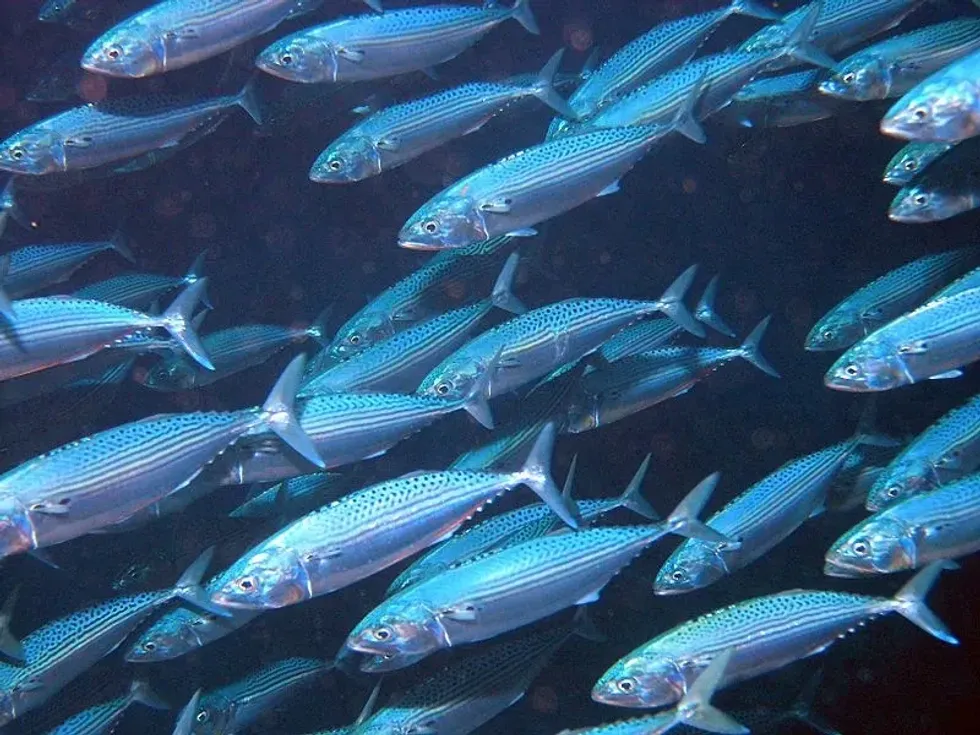Indian Mackerel, a member of the family Scombridae, is also known as Rastrelliger kanagurta scientifically. This fish can be easily found in the Indian and West Pacific oceans.
It is significant in the diet in the south of India like Tamil and Malayalam, and also in South-East Asian cuisines. The maximum lifespan of this fish is around four years.
This fish generally prefers shallow and coastal water. It is silverish and yellowish in color.
This fish has only a few scales behind the gill covers. People enjoy many different recipes with these mackerel fillets and it is quite common in India and has different names in different Indian states like Aiyla in Malayalam and Kaanankeluthi in Tamil. Indian Mackerel export has been steadily growing over the years because of its perceived health benefits.
The length and size of this fish are comparatively smaller and are small bony fish. This fish is distinguished by a corselet of enlarged or big scales near the shoulder part or region that goes over to the lateral line and the spots over its bodies.
It is quite gripping to know many facts about this fish so read on to discover them. If you are interested, read about chum salmon and rainbow trout too.
Indian Mackerel Interesting Facts
What type of animal is an Indian Mackerel?
Indian Mackerel is a species of fish.
What class of animal does an Indian Mackerel belong to?
It belongs to the class of Actinopterygii of fishes.
How many Indian Mackerels are there in the world?
There has been no specific number of these mackerel fishes recorded in the world.
Where does an Indian Mackerel live?
This fish is found in the Indian and Pacific oceans or Indo west Pacific coasts. It is also vastly found in the Tamil Nadu and Karnataka coastal belts.
It has a range that extends from East Africa and the Red Sea in the west to Indonesia in the east. It can also be found in the waters around China and the Ryukyu Islands in the north, down to Australia, Melanesia, and Samoa. As a Lesesspian migrant, the Indian mackerel is also found in the Mediterranean Sea.
What is an Indian Mackerel's habitat?
This fish is generally seen in shallow and coastal waters. It prefers water that has a surface water temperature of at least 63 degrees Fahrenheit or 17 degrees Celcius. Adults can also be found in coastal bays, deep lagoons, and harbors. These prefer turbid waters which are rich in planktons.
Who do Indian Mackerels live with?
It is believed that these fishes live in groups.
How long does an Indian Mackerel live?
It is believed that the Indian Mackerel can live up to four years.
How do they reproduce?
In the northern hemisphere, the breeding or spawning or mating season takes place from March-September in India. In the Southern Hemisphere around Seychelles, it begins around September to March.
It takes place in batches and these fish lay their eggs in the water. These eggs are then fertilized externally. These fishes do not protect their eggs but leave them to fend for themselves.
What is their conservation status?
It is believed that the data is inadequate to determine a threat category for this species of fish.
Indian Mackerel Fun Facts
What do Indian Mackerel look like?
This small bony fish has thin, dark bands that run lengthwise on the upper part, which could seem to be golden in fresh specimens. A black spot can be seen near the lower margin of the pectoral fin on the body.
The dorsal fins have a yellowish color with black coloration on the tips. The caudal and pectoral fins are also yellowish while the other fins are dusky in color.
This fish has only a few scales behind the gill covers.
The body of this fish is considered to be deep and the head is longer than the body depth or other organs. The maxilla is somewhat hidden or concealed and is covered by the lacrimal bone but extends around the hind margin of the eye.
How cute are they?
Some people think of fishes as cute and so, may find the Indian mackerel fish family cute too.
How do they communicate?
Not much information is available about the communication of the Indian Mackerel but it is believed that these fishes communicate with each other similar to other fishes using their chemical cues and other methods.
How big is an Indian Mackerel?
It is a small bony fish compared to some other pelagic fishes and can weigh around 0.31 lb (0.14 kg) and are up to 13 in (330 mm) in length.
How fast can an Indian Mackerel swim?
The exact speed of this mackerel fish is unknown but mackerels are known to be strong swimmers.
How much does an Indian Mackerel weigh?
This mackerel fish can weigh around 0.31 lb (0.14 kg).
What are their male and female names of the species?
There are no specific names for the males and females of the species.
What would you call a baby Indian Mackerel?
There is no particular name for a baby of this species. The parents lay eggs and then the baby fish can be referred to as fry, as is the case with other baby fish.
What do they eat?
It has been observed that this fish feeds mostly on plankton organisms. The food includes copepods, cladocerans, larval, and adult decapods, peridinians, and diatoms.
Are they dangerous?
This fish is believed to be highly toxic to a wide variety of organisms and humans too. It is considered hazardous to human health at concentrations above 1 mg/kg.
Would they make a good pet?
Not much information is available about this fish as a pet.
Did you know...
This fish is known by different and common names in different places. It is known as Pelaling in Malaysia and Indonesia.
This fish has different names in different areas of India. It is called Bangdo in the Konkani language, Bangdi or Bangda in Gujarati, in Bengali it is known as Kajol Gouri, in Malayalam it's Aiyla, Kaanankeluthi in Tamil, and in Tulu and Kannada it is known as Bangude.
There are over 30 different species belonging to or of the Scombridae family which are referred to as Mackerel.
Sometimes salmon and mackerel are confused for each other, the two species are not the same.
The term Mackerel has its roots in the old French and it is believed that it originally meant either marked or spotted or pimp or procurer.
In general, Mackerel are slimmer and smaller than tuna, Frigate Mackerels, or Auxis Thazard but in many aspects both the fishes are similar.
Allied to this species, are the chub mackerel that are more finely marked than the common ones.
It is sometimes recommended to avoid Indian Mackerel fish during pregnancy as well as other mackerel fish too.
Indian Mackerel fish in the USA and its parts are commonly found in frozen form and the frozen Indian mackerel fish tastes well too when fried.
Do people eat Indian Mackerel?
This fish is commonly used in South and South-East Asian cuisine. It is believed that this fish is rich in Omega-3 and Selenium, which is good for cardiovascular disease or health.
It helps lower blood pressure, helps in good eyesight, and reduces cholesterol and if you are trying to lose weight, this fish is a good option. However, it is considered hazardous to human health at concentrations above 1 mg/kg.
To enjoy this fish, the best way is to fry them in a light batter (rice flour is recommended but others work too) and eat with a simple sauce. The flavor of the flesh or the meat tastes good fried.
What are the differences between Indian Mackerel and Salmon?
Mackerels tend to be smaller bony fish than salmons, and the color of both can be different. Mackerels spend more time in water and have a silvery appearance and some dots over their bodies.
Salmons are known to have more diverse colors. Salmon's spawning happens in the nest built by their mothers while the spawning in Mackerels happens in the water and does not leave their habitat like salmons.
Salmons have higher Omega-3 content than mackerel but the latter has better content of Vitamin B12 and Calcium.
Here at Kidadl, we have carefully created lots of interesting family-friendly animal facts for everyone to discover! Learn more about some other fish including Spanish mackerel, or sockeye salmon.
You can even occupy yourself at home by drawing one on our indian mackerel coloring pages.










